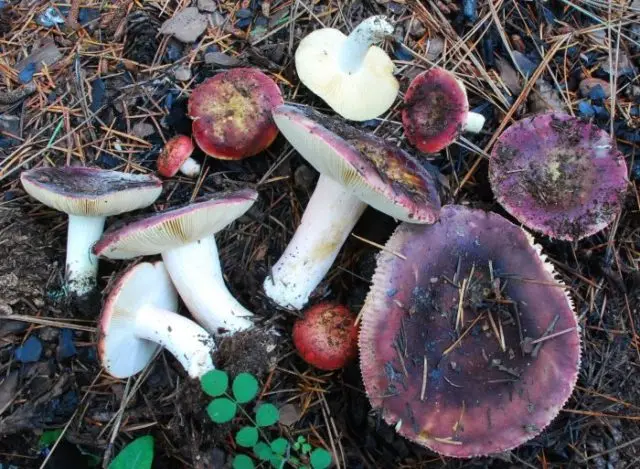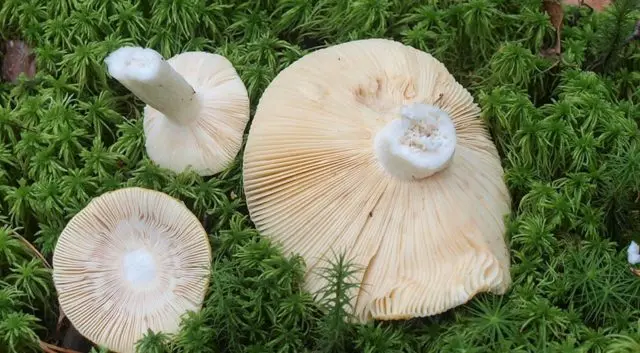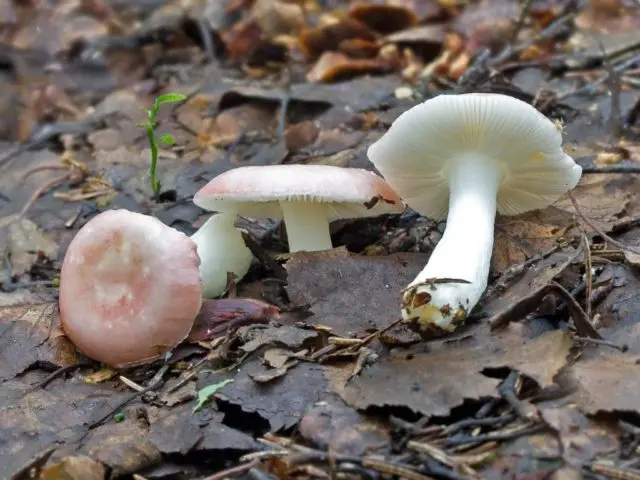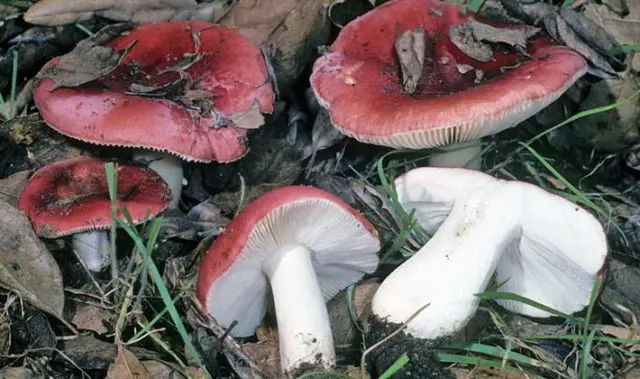Contents
- What do edible russula look like
- Where do edible russula grow
- Types of edible russula mushrooms
- Russula golden
- Russula blue
- Russula blue-yellow
- Russula marsh
- Russula green
- Russula greenish or scaly
- Russula greenish-brown
- Russula yellow
- Russula ocher or lemon
- Russula food or edible
- Russula is beautiful or pink
- Russula graying or fading
- Russula Turkish
- Russula whole (wonderful, flawless, brown-red)
- Russula green-red or kid
- Russula almond or laurel cherry
- Value
- Podgruzdok
- The benefits and harms of food russula
- False twins of edible russula
- How to distinguish edible russula
- When to collect edible russula
- Rules for the use of edible russula
- Conclusion
Mushrooms of the Russula family (Russulaceae) are represented by more than two hundred species, 60 of which grow on the territory of the Federation. Most of them are edible, but there are varieties that contain toxins and can cause poisoning. There are no deadly poisonous representatives among them, but so that the mushroom picking does not end in failure, you need to learn how to distinguish between them. Photos of edible russula and detailed descriptions given below will help an inexperienced mushroom picker not to make a mistake during the collection.

What do edible russula look like
Russula – agaric mushrooms, demonstrate the richness of colors and shades of color of the cap, plates and legs. They are similar in the form of fruiting bodies and developmental features at each stage of growth:
- Young specimens have a spherical or bell-shaped hat, which later becomes prostrate – flat, with a slight depression in the center or convex. In old ones, it becomes funnel-shaped, with a smooth, striped or ribbed edge. The color of the caps of edible russula can be yellow, pink, red, green, blue, black.

- The plates of edible representatives of the genus can be thin and frequent or wide and sparse, free or attached to the stem.

- The legs of edible mushrooms are most often cylindrical, straight, sometimes club-shaped. By structure, they are dense and made or hollow. Like the plates, they can be white or colored.

- The pulp of edible species is dense, strong or brittle, brittle, often white, and may change color with age or when broken or cut. The taste varies from sweetish to bitter-bitter.

Edible russula make up almost half of all mushrooms growing in forests.
Photo of edible russula mushrooms:
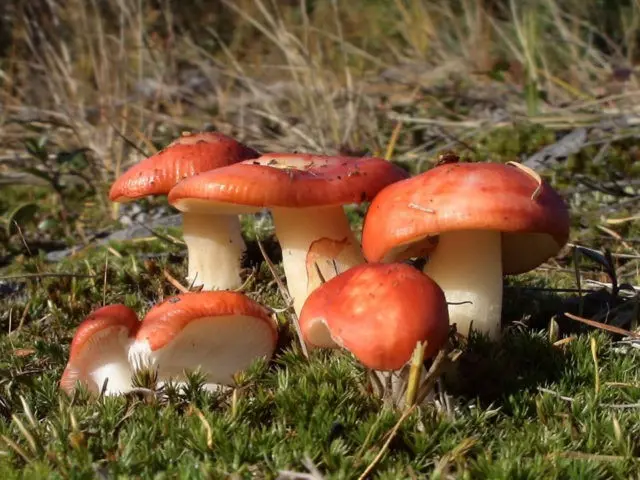
Where do edible russula grow
The habitats of edible russula vary depending on the species. Most of them prefer mixed forests, some species prefer only groves with a predominance of any one type of tree – spruce, birch, beech, or the outskirts of swamps. Each individual species of edible representatives of the species is in symbiosis with specific natural conditions, forms mycorrhiza with a certain tree species.
Types of edible russula mushrooms
All russula are divided into edible, conditionally edible and inedible. The former have an excellent taste, they can be consumed after short-term processing, dried, pickled, salted. The latter have a bitter pungent taste and require special preparation. Such mushrooms are not subject to drying. Still others are very toxic and should not be eaten. The following are descriptions and photos of edible russula mushrooms.
Russula golden
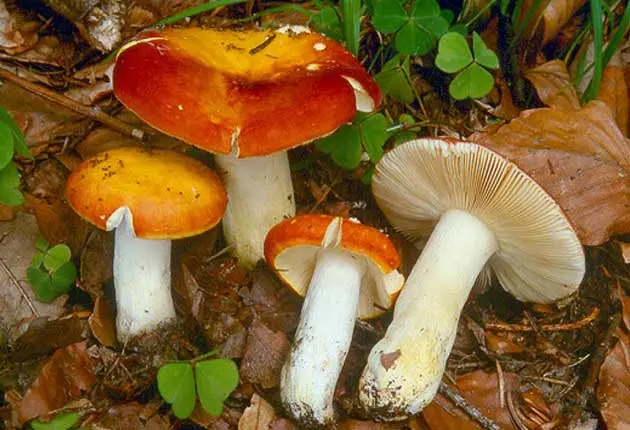
It got its name from the golden-yellow color of the hat. The leg of an edible mushroom is white, with a yellowish tinge, cylindrical or club-shaped, naked, 3-8 cm long, up to 3 cm thick. The hat is 5-12 cm in diameter. In a young mushroom, it is hemispherical, convex, later convex-prostrate or flat-depressed, fleshy, with a smooth or slightly ribbed edge. The surface is first naked, slimy and shiny, cinnabar red. Later – matte, velvety, with red spots on a yellow background, orange with rounded edges. The plates are frequent, free at the stem, rounded at the edge, cream or yellow. The flesh is whitish, tasty, odorless, very fragile in adulthood, crumbles a lot. Grows from June to the end of September. Edible delicious mushroom.
Russula blue
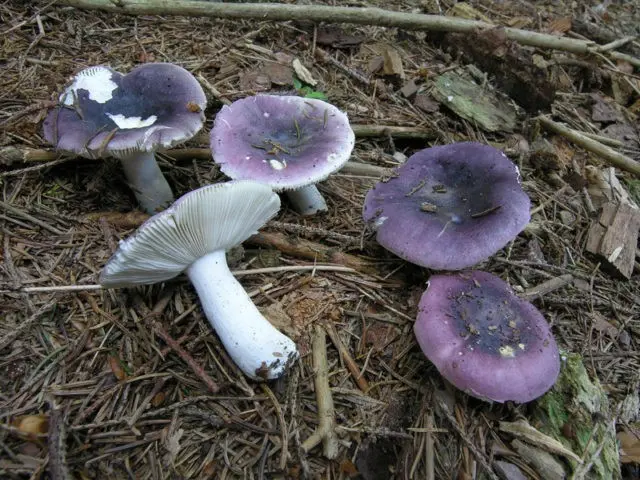
Bulky, fleshy, edible mushroom. The cap is up to 8 cm in diameter, convex in young fruiting bodies, and flat in mature ones with a depression in the middle. The skin is blue, blue-lilac, darker in the middle – black-olive or black-lilac, easily separated. The plates are white, branched to the edges. Leg 3-6 cm in height, white, dense at first, later loose, hollow. The flesh is strong, white, odorless, with good taste. It grows in sparse spruce forests in August-September.
Russula blue-yellow

Despite the name, the color of this edible mushroom is varied. The hat can be gray-green, graphite, blue-gray, purple, bluish-greenish, yellowish in the center and pink around the edge. Its diameter reaches 5-16 cm. In wet weather, the surface of the cap becomes sticky and shiny. The plates are elastic, non-brittle, frequent, first white, later creamy yellow. The leg is cylindrical, dense, porous and fragile in mature russula, 5-12 cm tall, naked, wrinkled, in places with a slight purple tint. The pulp is elastic, juicy, white, with a nutty flavor, odorless. Grows from June to the first snow in coniferous and mixed forests. One of the most delicious mushrooms among the edible varieties of the genus.
Russula marsh

Another name for an edible mushroom is Float. The hat of a young marsh russula is semi-conical or prostrate, with a small notch in the middle and lowered edges, reaches 15 cm in diameter. Its surface is smooth, shiny, sticky, bright red, dark in the center. The plates are loose, infrequent, wide, white or yellowish. The leg is long, up to 12 cm long, thick, made or hollow, white or pinkish. The pulp is tender, friable, brittle, white. Swamp russula grows in damp pine-birch forests, in blueberries, on the outskirts of swamps, among moss. Prefers peaty soils. The time of formation of fruiting bodies is July-September.
Russula green
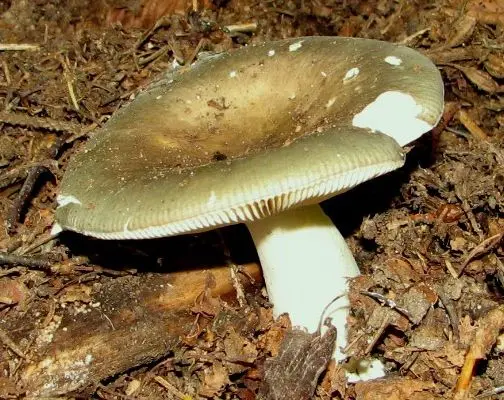
It has a sticky, thin, protruding cap with a ribbed edge, up to 14 cm in diameter. In a young mushroom, it can be whitish, pale green, and as it grows, it acquires a grassy green or yellowish-brown color. The skin is slimy, glutinous, glossy in dry weather. The plates are white at first, later yellowish, frequent, thin, rounded at the edge of the cap. Leg up to 8 in height, cylindrical in shape, at first dense, later porous. It has a white, smooth, shiny surface and characteristic rusty spots at the base. The pulp is dense, white, with a slight burning taste. Boiling relieves the fungus from burning. It grows in abundance in birch forests, bears fruit in June-October.
Russula greenish or scaly
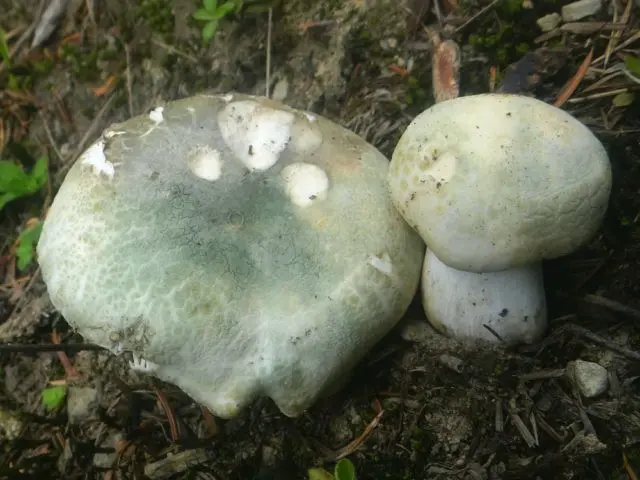
One of the most delicious varieties of edible russula. It has a greenish or grayish-green, spotted, flattened-depressed hat with thick wavy ribbed edges. The skin is dry, rough, cracking into small scales. The plates are frequent, white or yellowish. The leg is cylindrical, up to 12 cm tall, at first hard, as it grows, it becomes spongy and brittle. The pulp of young mushrooms is very dense and crispy, becomes soft with age, crumbles a lot. It is white in appearance, turns yellow on the cut, has a sweetish nutty taste and a faint aroma. It grows from June to the first snow in mixed deciduous forests, often under oaks and birches.
Russula greenish-brown

A very rare species, proposed for inclusion in the Red Book in several regions of the Federation. Fruiting bodies consist of a flat, slightly depressed in the center cap with a slightly ribbed edge and a dense, even, white central leg 3-6 cm long. The skin is yellow-green, greenish-brown with an ocher or olive tint in the center, dry, matte, smooth . The plates are white or creamy, thin, fragile, forked-branched. The pulp is dense, but brittle, white, with a pleasant taste, without aroma. Grows from July to October in coniferous-broad-leaved foxes, forms mycorrhiza with birch, oak, maple.
Russula yellow
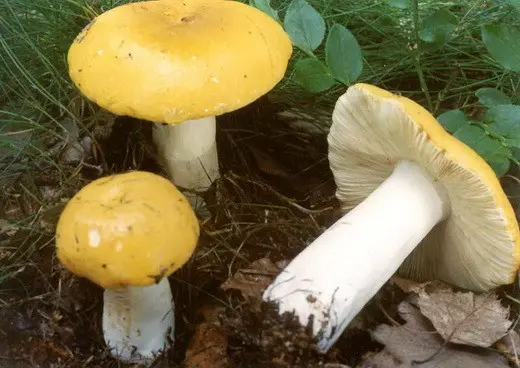
An edible mushroom is easily recognizable by its intense yellow cap, sometimes greenish in the center. In young fruiting bodies, it is hemispherical, later becoming flat and funnel-shaped with a smooth wrapped edge. The peel is shiny, dry or slightly sticky, smooth, removed up to half of the cap. The plates are white, yellowish, gray with age or damage. The leg is white, even, dense, cylindrical in shape, grayish at the base. The pulp is strong, white, darkening on the cut and during cooking, has a nutty, slightly spicy taste and a sweetish aroma. It grows in damp forests, along the outskirts of swamps, bears fruit from mid-July to October.
Russula ocher or lemon

The most common variety of russula, a conditionally edible mushroom. The color of the mushroom cap is yellow or yellow-ocher, less often greenish-yellow. The skin is smooth, moist, separated only along the edge of the cap. The plates are rare, thin, brittle, adherent. Leg 4-7 cm in height, straight or slightly curved, cylindrical, white, smooth or slightly wrinkled, glabrous. The flesh is brittle, white, yellowish under the skin, darkening at the break, tastes fresh or bitter, sharp at the plates. It grows in May-October in deciduous forests, oak and birch groves.
Russula food or edible
Photo of russula food:
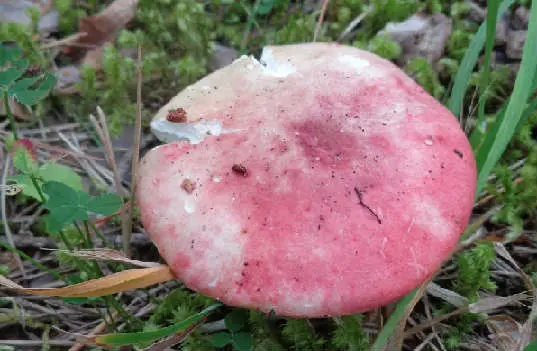
One of the most popular types of edible russula among mushroom pickers. It has a plano-convex pink-white or pinkish-brown with spots hat up to 11 cm in diameter, with a slightly sticky or matte surface. The plates are frequent, white or cream, sometimes with rusty spots. The leg is short, up to 4 cm long, white, becomes stained over time, like the plates. The pulp is dense, white, with a pleasant nutty taste. Mushrooms are collected from late June to October in coniferous and coniferous-deciduous forests.
Russula is beautiful or pink
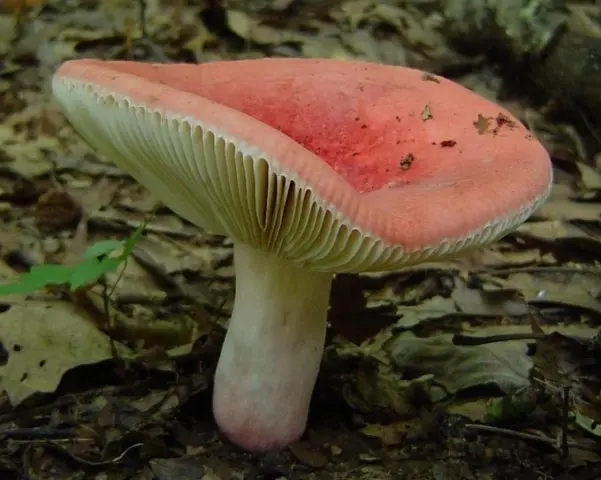
The hat is small, 5-10 cm in diameter, with smooth edges. The skin is bright pink or deep red, fading, tender to the touch, velvety, slightly mucous after rain. The plates are white or creamy, adhering to a short straight leg, painted white. Sometimes with a pinkish tint. The pulp is dense, white, bitter, without aroma. Grows in August-September in deciduous forests, often in the roots of birches and beeches, can be found on calcareous or sandy soils.
Russula graying or fading
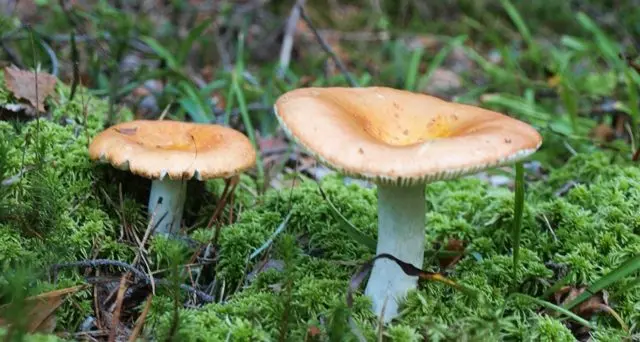
It got its name due to the property of the pulp to become gray when broken or with age. The cap is fleshy, up to 12 cm in diameter, hemispherical in young fruiting bodies and flat-convex or depressed in mature ones. It is painted in brownish-red, brown-orange, yellow-brown colors, has a smooth, dry, matte surface. The plates are frequent, wide, white in young specimens and dirty gray in old ones. The leg is rounded, made, up to 10 cm high, smooth. Sometimes wrinkled. The pulp is dense, in overripe mushrooms it is fragile, with a sweetish taste and a weak aroma. Grows from June to October in moist pine forests.
Russula Turkish
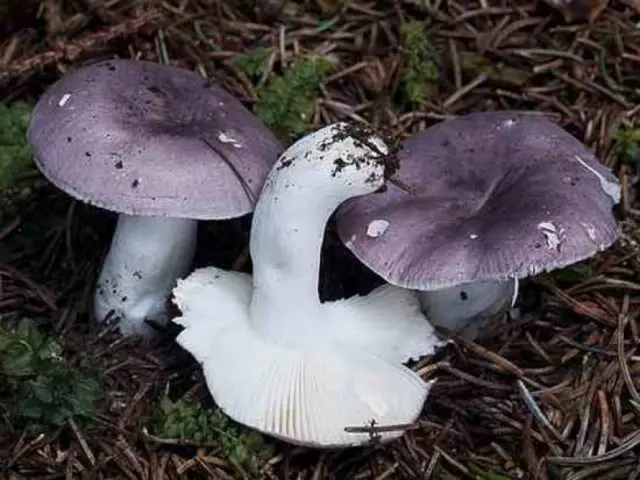
An edible mushroom with a characteristic lilac or purple-brown color of the cap. It has a shiny mucous skin, which becomes “felt” when it dries. The plates are white or light yellow, frequent, adherent. The leg is cylindrical or club-shaped, white or pink, in wet weather it acquires a yellowish tint. The flesh is white, brittle, with a lilac tint under the skin, in a mature mushroom it is yellow, sweetish, with a pronounced fruity smell. Grows in coniferous forests, fruiting bodies appear in July-October.
Russula whole (wonderful, flawless, brown-red)
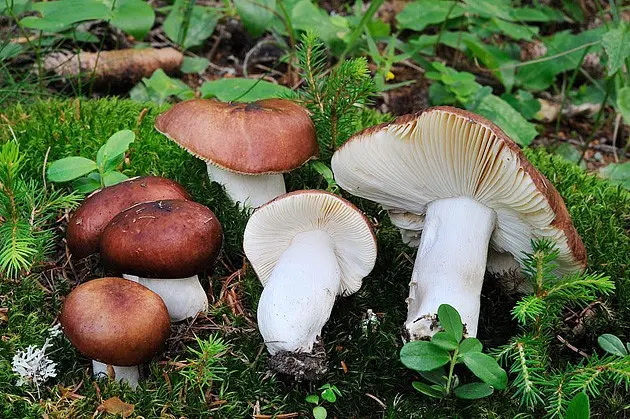
The color of the whole russula cap can be red-brown, olive-yellow, chocolate, pinkish-red. The plates are frequent, white or cream-colored. The leg is straight, slightly narrowed downwards, white with a pinkish bloom. At first it has a dense structure, later it becomes porous, and then hollow. The pulp is tender, white, fragile, sweetish, slightly spicy in a mature mushroom. Grows from July to October in mountain coniferous forests.
Russula green-red or kid
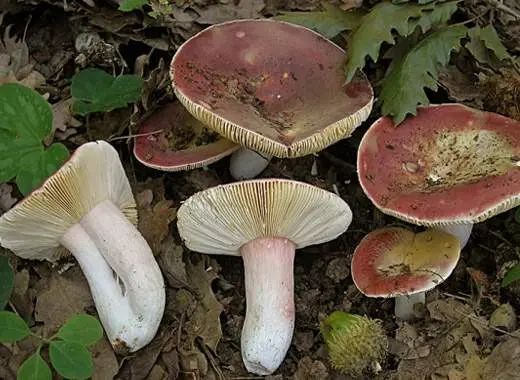
Edible mushroom, has a fleshy prostrate or spherical hat with a diameter of 5-20 cm, a smooth or slightly lined edge, purple-red or red-brown color. The plates are thick, adherent, creamy. The leg is straight, solid inside, white, may be with a pinkish or yellowish tint. The flesh is white, yellowish under the skin, has no bright taste or smell. It grows in mixed deciduous forests with a predominance of maple and beech.
Russula almond or laurel cherry
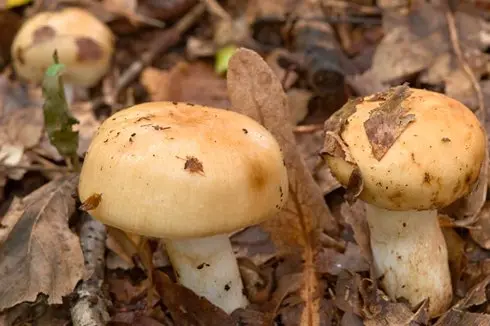
It has a medium-sized hat with a ribbed edge. The color of the edible mushroom changes from ocher yellow at the beginning to brown-honey in adulthood. The plates are white or beige. The leg is regular in shape, smooth, porous, brittle, painted in light colors from above, turning brown at the base. The pulp of an edible mushroom is white, fragile. At the cap, it does not have a bright taste, at the stem it is pungent and spicy with an almond aroma. It grows in deciduous mixed forests, beech and oak groves, it is harvested all summer and autumn.
Value
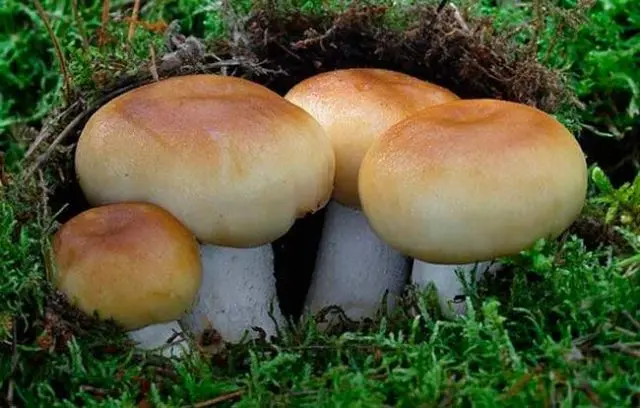
There are many names for this subspecies: goby, fist, snotty mushroom, plakun mushroom, pig, egg capsule. The hat is up to 5 cm high, up to 15 cm in diameter, light brown in color, has the shape of a hemisphere, becomes flatter and slightly concave during growth. Cream-colored plates secrete a clear yellowish juice. The flesh is white, brittle, has a burning bitter taste and an unpleasant smell of rancid oil. The leg is straight, long, hollow, fragile. It grows in damp shady places, in mixed forests with a predominance of birch.
Only valuya hats are prepared, removing the bitter skin from them. Delicious only in salted, pickled form.
Podgruzdok
In nature, there are three types of podgruzdki – black, white and blackening. These are conditionally edible mushrooms, going only for salting after preliminary soaking and boiling.
Loader black
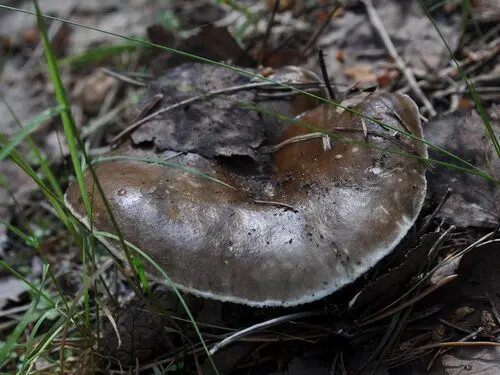
The mushroom has a flat-depressed, later funnel-shaped cap with a slightly sticky surface, a grayish, olive-brown dark brown color. The plates are frequent, grayish, have a bitter taste. The leg is short, thick, smooth, the same color as the cap or slightly lighter, darkens when touched. The pulp is fragile, white or gray, sweetish-sharp.
White loader

In another way, it is also called “dry load”. A funnel-shaped white dry cap with brownish-yellow zones cracks during the dry period. The plates are thin, white or bluish-white, with a strongly pungent taste. The stem is short, white, hollow in a mature mushroom. The pulp is dense, with an ordinary unleavened taste. Grows in forests of any type from June to November.
Blackening loader
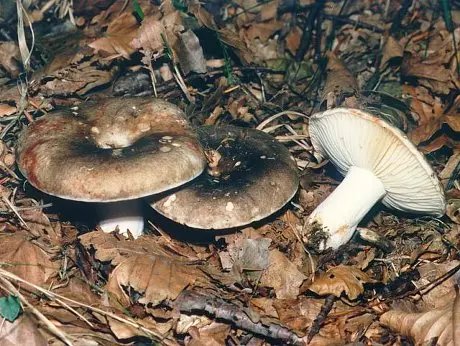
The cap of the mushroom is white at first, gradually darkens with time – it becomes grayish, brownish-brown. Adhering particles of dirt and forest debris linger on its smooth sticky surface. The plates are thick, large, rare, at first white, then darken – they become grayish, brownish and even black. The leg is cylindrical, solid inside, smooth, dry, matte. In a young mushroom, it is white, later brown, then black. The pulp is dense, fleshy, with a sharp taste. When broken, it first turns red, then blackens.
The benefits and harms of food russula
Edible russula is a dietary product that leaves a feeling of satiety for a long time. They contain proteins, carbohydrates, omega-3 and omega-6 polyunsaturated fatty acids, vitamins B, C, E, micro and macro elements. The use of edible russula helps to strengthen the immune system, normalize the functioning of the cardiovascular and nervous systems.
The use of edible russula has its contraindications. They are among the hard-to-digest foods, heavy on the stomach and are not recommended for people with digestive disorders. Also, edible russula should not be introduced into the diet of children under 7 years old.
False twins of edible russula
In the forests and swamps there are inedible russula, which, by external signs, can be mistaken for edible. The most dangerous double is the deadly poisonous fungus pale grebe. Mature grebes with wide caps of different colors are often confused with russula, especially with green and greenish (scaly) varieties. It is easy to distinguish a poisonous mushroom from an edible one by thickening at the base of the stem and a fringed border – a “skirt” just below the hat.

Edible russula can also be confused with non-edible species of the genus Russula. They do not contain poison that is dangerous to the body, but they have the ability to irritate the gastric mucosa, cause vomiting and pain. In addition, their pulp has a bitter, very pungent taste.
Russula caustic (bug-eating, emetic)
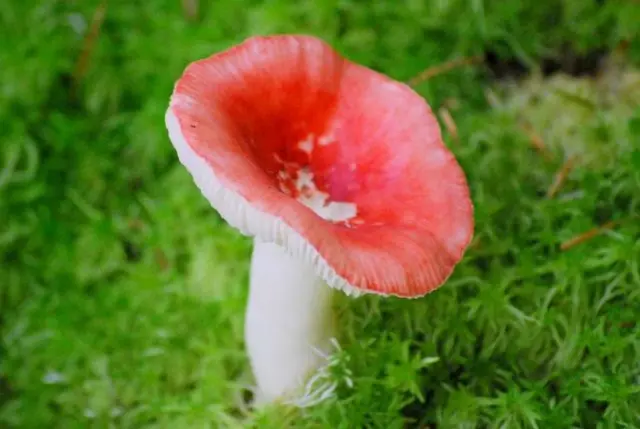
It is recognizable by its red cap with a ribbed edge, greenish-yellow plates, white stem turning yellow at the base, spongy damp flesh with a sharp taste and fruity aroma. Some experts consider the mushroom poisonous, others – conditionally edible. It is salted and marinated after a long soak and boiled twice.
Russula brittle
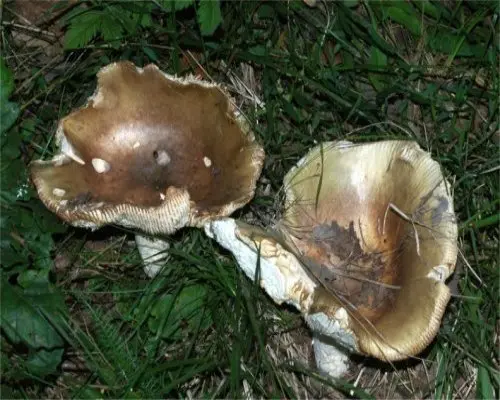
The mushroom changes color in the process of growth, its hat is first pink-violet, then fades. It has a diameter of 3-6 cm, flat-concave shape, short scars along the edge, on the purple skin in places there are blurry gray-greenish spots. The plates are wide, sparse, yellowish. The leg is straight, white, later creamy. The pulp is fragile, brittle, white or yellowish, strongly bitter, has a sweet smell. The mushroom is conditionally edible.
Russula blood red
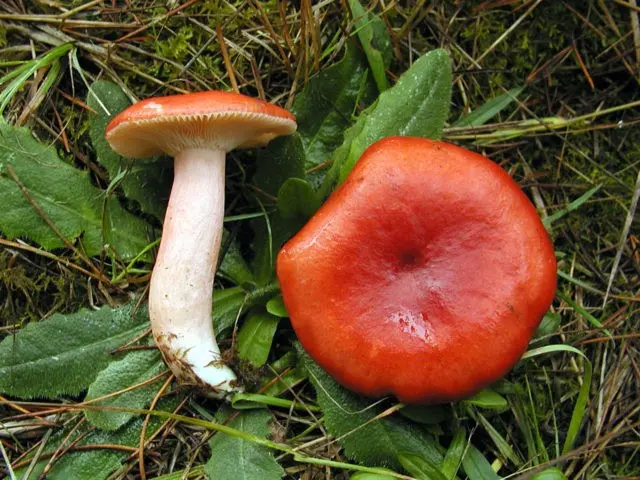
The cap of the mushroom is red, pink, scarlet, wavy or ribbed along the edges. In dry hot weather, it fades, turns pale, in damp its surface becomes sticky. The leg is often painted in pink shades, less often it is gray. This species is not considered edible.
Russula birch
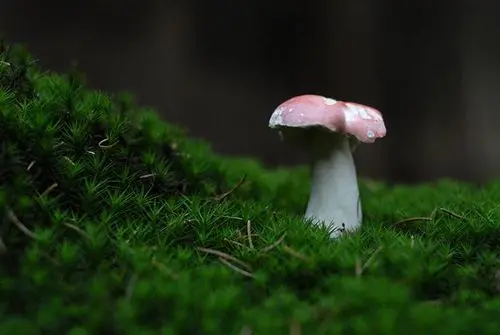
It has a thick, lilac-pink hat with yellowness in the middle, white fragile flesh with a pungent taste. The skin of the fungus contains toxic substances that cause poisoning. The use of birch russula for food is possible with the obligatory removal of the upper film.
Russula bitter or spicy
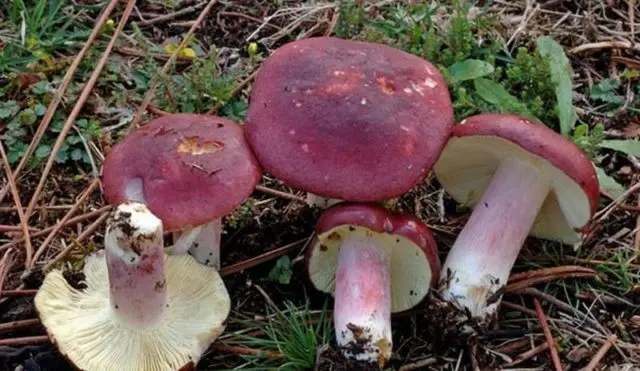
The hat is lilac or light purple, darker in the middle, the stem is even, smooth, pink or purple. Its flesh is yellow, has a sharp pungent taste. It is not used for food.
Russula Mayr or conspicuous
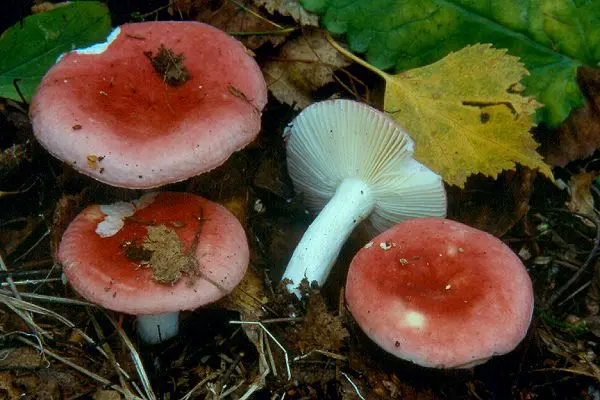
The cap of the mushroom is painted in a rich red color, which fades to reddish-pink over time. The leg is very dense, white, brownish or yellowish at the base. Slightly poisonous, inedible species of the genus Russulaceae.
Syroezhka Kele
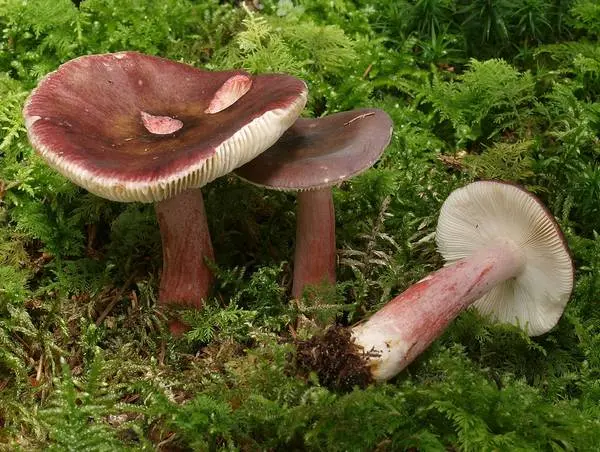
A dark purple hat with greenery around the edges, a purple-pink leg make it easy to recognize, not to confuse Kele russula with edible varieties.
How to distinguish edible russula
Edible russula have so many similarities with inedible ones that even experienced mushroom pickers make mistakes when choosing. They prefer to collect varieties of green, yellow, blue, brown, brown shades and try to avoid bright red and poisonous lilac mushrooms. Many mushroom pickers believe that any russula is edible, you just need to know how to cook them. They consider the pale grebe to be the only poisonous “russula”, but it is easy to identify it by its legged skirt. Otherwise, the following signs should be alarming during examination:
- dense pulp and rough plates;
- stains and veins on the leg;
- unpleasant odor;
- bitter taste;
- color change during cooking;
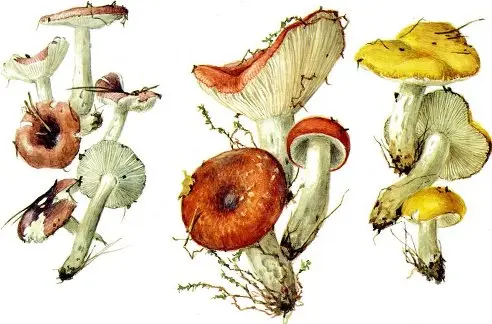
If the appearance or smell of the mushroom is in doubt, you do not need to pluck it, much less cook it.
When to collect edible russula
The harvest time for edible russula varies depending on the species. The general time for quiet hunting is July-October. Some varieties form fruiting bodies as early as June or continue to grow until the first frost. Edible mushrooms are considered suitable for collection, the caps of which have not yet unfolded. Later they overripe, become very brittle and practically unsuitable for transportation. In addition, with age, fruiting bodies accumulate toxic substances from the environment. The caps of many edible russulas have a slimy, sticky surface that sticks to grass, earth, and other forest debris. It must be removed very carefully so as not to damage the fragile body of the fungus.
Rules for the use of edible russula
Despite the name, edible species are not eaten raw. It takes a minimum of time to prepare them, 15-20 minutes is enough. If the skin of a conditionally edible mushroom is bitter, it must be removed, if not, then it is better to cook with it, this will help preserve the integrity of the product. Conditionally edible mushrooms are soaked for 2 hours, periodically changing the water, then boiled for 5 minutes, and only after that they begin the main cooking process – frying, baking, salting, pickling. They can serve as a side dish for meat or be an independent dish.
Conclusion
Russula are an extensive family of mushrooms that grow in abundance in forests, glades, city parks, and swamps. Among them there are both tasty and not very tasty, as well as bitter varieties. Photos of edible russula, as well as their burning bitter relatives, will help you learn to distinguish and choose them while collecting the best representatives of the species.










